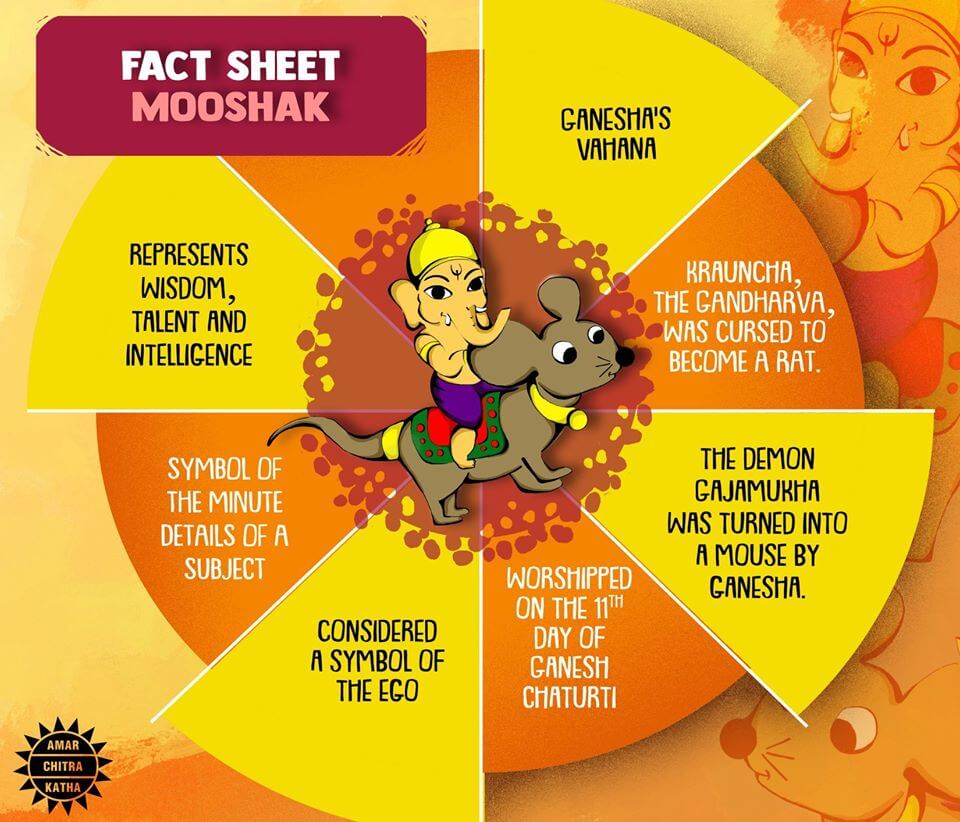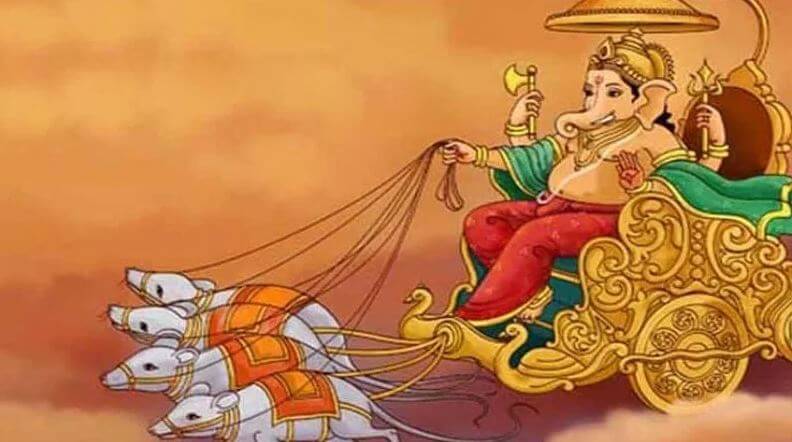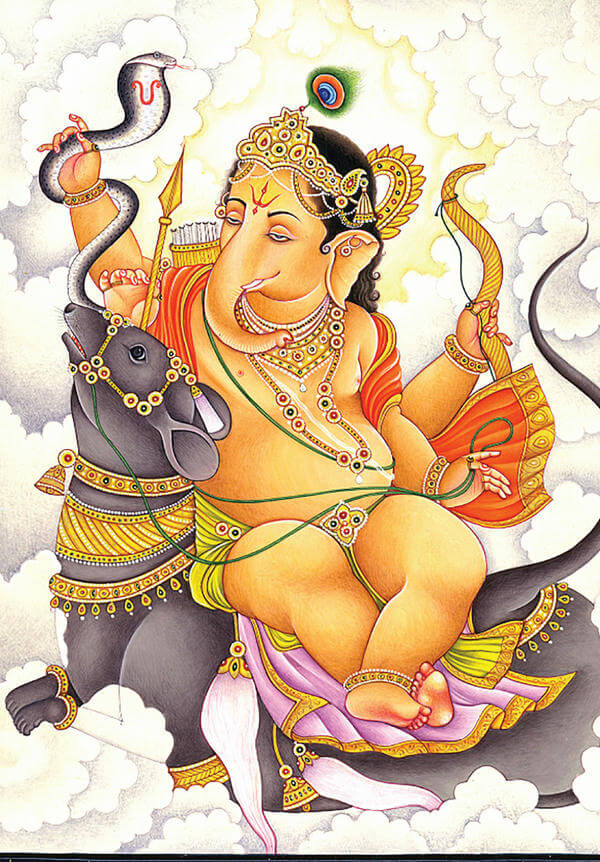
The name Ganesha is derived from the Sanskrit words gana meaning a ‘group, multitude, and isha (īśa), meaning ‘lord or master’. Even the name Ganapati means master of the troop of semi-divine beings who form part of the entourage of Ganesha’s father Lord Shiva. Lord Ganesha has many other titles and epithets, including Ganapati (Ganpati), Vighneshvara, and Pillaiyar. Most often the title Shri is added before his name as a mark of respect.
One of the best-known and most worshipped deities in the Hindu pantheon Lord Ganesha is the Supreme God of the Ganapatya sect throughout India. Many of his followers can be found in States, Nepal, Bangladesh, Sri Lanka, Indonesia, Thailand, Myanmar, China, Japan, Fiji, Guyana, Mauritius, as well as Trinidad and Tobago.
Have you ever wondered why Lord Ganesha choose a mouse as his ride (vehicle or vahana)?
Well, the story goes that Ganesha asked the rat to be his vehicle, after a battle with Gajamukha demon who did severe penance and obtained invincible powers from Lord Shiva as per the advice of Guru Shukraachaarya – the spiritual guide of the asuras (demons). Once he got the powers demon Gajamukha started harassing the gods who turned to Lord Ganesha for help. Lord Ganesh battled with the demon but things were not all that easy considering Lord Shiva’s blessings which made in invincible. So Lord broke one of his tusks and threw it at Gajamukha cursing him to be transformed into a mouse. Lord Ganesha thereby got on to the back of the mouse and made it his vehicle. The idea behind all this was to keep it under his control.

According to another Puranic story, Ganesha’s rat was actually Krauncha a Gandharva or a heavenly musician who was cursed by Vamadeva Muni. Once, while attending Lord Indra’s court, Krauncha accidentally stepped on sage Vaamadeva’s feet who got so annoyed that he cursed Krauncha to be transformed into a rat. Kraunch apologized to Muni but he could not take back his curse. So he gave Kraunch a boon that he would become the ride of Lord Ganesha.
But then Kraunch was a gigantic mouse who used to engulf huge mountains in minutes. He used to trouble the sages living in the forest. One day he entered Sage Paraashara’s ashram along with a large number of his friends and relatives and started causing havoc. Perturbed by this unexpected intrusion, Sage Paraashara appealed to Lord Ganesha seeking his help to save him and his disciples. Hence Lord Ganesha appeared and brought the rat under his control.
Hence it really makes no difference which Puranic story is true. The purpose of making the rat Lord Ganesha’s vehicle was to keep it under control and prevent it from causing any damage. The rat represents greed and uncontrollable desire that nibbles or destroys everything. Rats are a big problem for farmers in India. For farmers all over India, rats are their biggest enemy. By making rat his vehicle Ganesha keeps the rats in control and distracts them from damaging the crops and grains. It is only natural for Ganesha – the remover of all problems to solve this problem too.
Interestingly the arrogant mouse did not readily accept Lord Ganesha as his master. Lord Ganesha threw a noose to catch the mouse who tried to hide in Patal Lok. So Lord Ganesha trapped the mouse and brought it back to Mount Kailasa. Once they reached Mount Kailasha Lord Ganesha asked the rat the reason behind the devastation. But the angry rat kept quite and did not give any suitable answer. So Lord Ganesha told him – you are now in my shelter, so ask whatever you want, but do not disturb Maharishi Parashar.
However, instead of asking anything for himself, the proud mouse in turn asked Lord Ganesha to ask him anything. Impressed by his attitude Lord Ganesha told him that he wanted to ride it. The rat obeyed and got ready but as soon as Ganesha sat on top of him, he collapses on the ground because of the heavyweight. Despite trying his best the rat could not move even a step forward. The rat’s pride was shattered. So he said to Ganeshji, “Please forgive me Ganpati Bappa. I am being crushed by your weight”. Lord Ganesha didn’t just accept his apology, but also accepted the mouse his ride.

Since that day the mouse can be seen placed near Lord Ganesha’s feet in most of the temples and sculptures. The mouse is also mentioned in the Brahmananda Purana, Matsya Purana and Ganesha Purana. The mouse or mooshak is worshipped on the eleventh day of Ganesh Chaturthi. The mooshak symbolises the ego that can nibble away all virtues and must be subdued. The mooshak represents wisdom, talent and intelligence.
Also read: How many species of rats are there in the world?
The Mudgala Purana a Hindu religious text dedicated to Ganesha includes many stories and ritualistic elements relating to Ganesha. The Ganesha Purana, Mudgala Purana and the Ganapati Atharvasirsha are the principal texts dedicated to Ganesha – the siddhi data or giver of success and abundance in life.
The Mudgala Purana describes eight incarnations of Ganesha the all-pervading, all-knowing and most benevolent deity prevailing over eight human weaknesses or demons. These include:
Vakratunda – (curved trunk) is the vanquisher of matsarya, jealousy. He is mounted on a lion.
Ekadanta (“single tusk”) is the conqueror of arrogance or conceit. He is the single-tusked one who undertook to write Mahabharata dictated by sage Vyasa. His mount is a mouse.
Mahodara (“big belly”) is the lord of moha or infatuation. The purpose of this incarnation is to overcome the demon Mohāsura (delusion, confusion). His mount is a mouse.
Gajanana (elephant face) conquers lobha, greed. The purpose of this incarnation is to overcome the demon Lobhāsura (greed). His mount is a mouse.
Lambodara (“pendulous belly”) overcomes krodha, anger. The purpose of this incarnation is to overcome the demon Krodhāsura (anger). His mount is a mouse.
Vikata (“unusual form”, “misshapen”) conquers kama, lust. The purpose of this incarnation is to overcome the demon Kāmāsura (lust). His mount is a peacock.
Vighnaraja (“king of obstacles”) – Vighneshvara- is the lord of obstacles. As Vighneshvara, lord Ganesha creates difficulties and obstructions in our path if the time is wrong for us to proceed and removes obstacles if and when we are bound to succeed. This is why we prostrate before Vighneshvara before we undertake a task, plan a change or pray before any God. The purpose of this incarnation is to overcome the demon Mamāsura (possessiveness). His mount is the celestial serpent Shesha.
Dhumravarna (smoke coloured) overcomes abhimana, pride. The purpose of this incarnation is to overcome the demon Abhimanāsura (pride, attachment). His mount is a mouse.
The two Shaktis of Lord Ganesha
Buddhi and Siddhi are the two companions of Lord Ganesha. Buddhi symbolizes wisdom or the intelligent and discriminating use of knowledge. Siddhi stands for success, contentment, achievement or completion.

